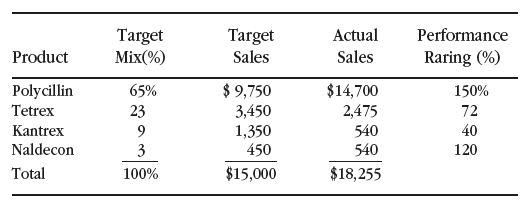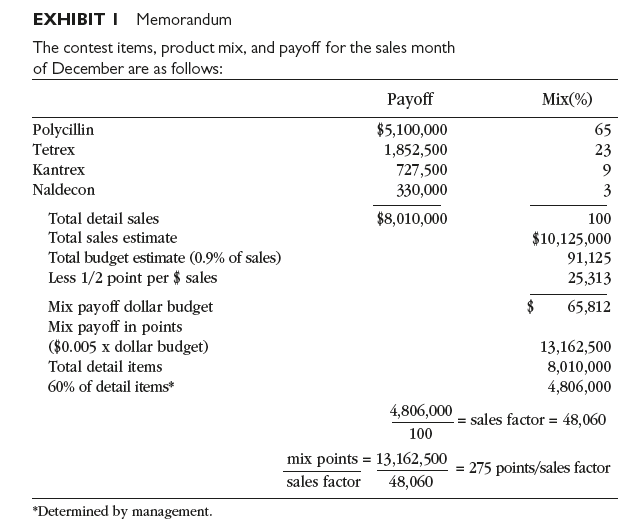Bristol Laboratories, a division of Bristol-Myers, was one of the world’s largest manufacturers of antibiotics and pharmaceuticals. It had 725 salespeople deployed throughout the United States. With a sales organization of this magnitude, Bristol faced managerial problems in motivation and in balancing the selling emphasis given its product lines. Sales force management used sales contests to motivate and direct the sales staff, These ran continuously each month throughout the year.
Bristol’s major brands included Tetrex, Saluron, Syncillin, Kantrex, Nalde-con, Polycillin, Staphciliin, Prostaphlin, and Salutensin. Hospitals and drug wholesalers purchased direct from the company. Ultimate consumers bought Bristol’s products from retail druggists on doctor’s prescriptions.
Bristol’s sales force was organized into ten regions’containing sixty-five sales districts. Sales personnel were distributed within districts according to the sizes of individual territories and relative sales potentials. Their duties included calling on doctors, hospitals, and drug wholesalers, and making service calls on retail drugstores. Each salesperson visited an average of 120 doctors, ten hospitals, and two wholesalers per month.
The sales force compensation plan consisted of a relatively small salary plus a relatively generous 5 percent commission on territorial sales volume. K. J. Ryan, sales manager, believed that his salespeople were among the highest paid in the drug field. They averaged over $23,000, the top person earning over $49,000.
Through its sales contests, Bristol sought to direct salespersons toward emphasizing all products in the line instead of only the high-commission, easy-to-sell items. While contests ran continuously, different products received emphasis each month. Ryan thought money was less important than merchandise and travel awards, especially to a highly paid sales force. Salespersons competed against territorial sales goals; management believed that other bases for contests would have caused morale problems, as salespeople worked different territories and had varying selling abilities. In all contests, the closer a salesperson came to established targets, the greater was the reward.
Maritz, Inc., a firm specializing in organization and operation of sales incentive campaigns, planned and administered Bristol’s contests. Four diffeent drugs were promoted each month. In December these were Polycillin, Tetrex, Kantrex, and Naldecon. The marketing department estimated dollar sales and the percentage of each drug that should comprise a salesperson’s total effort. December’s target mix was 65 percent Polycillin, 23 percent Tetrex, 9 percent Kantrex, and 3 percent Naldecon.
The contest scoring system involved awarding prize points in two categories: (1) total sales of the four drugs and (2) performance relative to the target sales percentage mix. For each dollar of total sales, one half of one prize point was awarded (for example, $20,000 total sales = 10,000 prize points). Points awarded in the second category “mix points,” were based on performance relative to the target sales mix. For example, salesperson X had actual sales in December as follows:

If X’s sales had equaled the target sales, all the performance ratings in the last column would have been 100 percent. This column represented the percentages of drugs sold relative to the mix goal. Prize points (“mix points”) were calculated by multiplying the lowest performance number by the “sales factor” established by management (see Exhibit 1). X’s mixpoint total was 11,000 points (40 x 275 = 11,000). The lowest performance number was used in an effort to motivate sales personnel to make sales proportionate to management’s target percentages. Total prize points earned by X were:

Had X sold the exact targeted product mix, his mix-point would have been 27,500 and his total prize points 47,628.

“Prize-point” checks were mailed monthly and were exchangeable for merchandise described in the Maritz catalogue. Each prize point was worth $0.005 (20,128 points = $100.64). Management withheld the proper income tax each month. Points could be exchanged for almost any item imaginable, from airplanes to pearls. Travel awards consisted of trips to such places as London, Casablanca, and Tel Aviv.
Source: Richard R. Still, Edward W. Cundliff, Normal A. P Govoni, Sandeep Puri (2017), Sales and Distribution Management: Decisions, Strategies, and Cases, Pearson; Sixth edition.

Yeah bookmaking this wasn’t a risky conclusion great post! .
I truly enjoy looking at on this internet site, it contains superb articles.